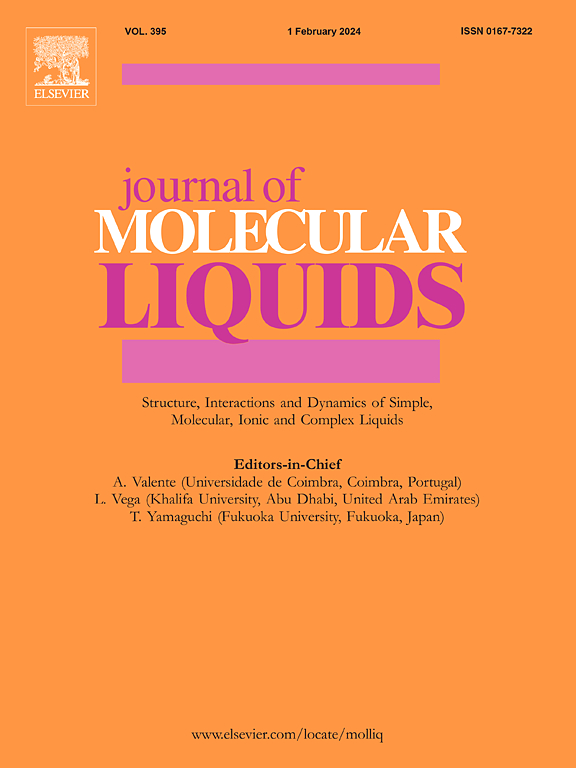快速流体制备用压裂增稠剂P(AM/AA/AMPS/NVP/DMAAC-16)的合成及性能研究
IF 5.3
2区 化学
Q2 CHEMISTRY, PHYSICAL
引用次数: 0
摘要
为满足油田压裂作业对快速制备工作液的要求,采用反相乳液聚合的方法合成了一种乳化型增稠剂P(AM/AA/AMPS/NVP/DMAAC-16)。以丙烯酰胺(AM)、丙烯酸(AA)、2-丙烯酰胺-2-甲基丙烷磺酸(AMPS)、n -乙烯基吡罗烷酮(NVP)和十六烷基二甲基丙烯酰氯化铵(DMAAC-16)为原料进行了合成。通过单因素实验探讨乳化剂用量、油水比、单体摩尔比、单体用量、水相pH、引发剂用量、反应温度、反应时间等因素对实验的影响。确定了最佳合成条件如下:一个oil-to-water体积比为0.7,乳化剂的量是5%(相对于油相的质量),引发剂浓度0.03%(相对于总反应系统质量),4小时的反应时间,反应温度为50°C, 7的水相pH值,和一个总单体浓度35%的总系统质量,摩尔比率的n(点):n (AA): n(安培):n(一步法):n (DMAAC-16) = 86.2: 9.7: 3.3: 0.4: 0.4。对产物进行了x射线衍射分析(XRD)、红外光谱分析(FTIR)和扫描电镜分析。表征结果表明,合成产物具有目标产物的特征。研究表明,P(AM/AA/AMPS/NVP/DMAAC-16)聚合物具有优异的溶解性和良好的应用性能,有效解决了传统水基压裂液体系在储运过程中存在的吸湿、变质、溶解和制备时间长、粉体增稠剂制备复杂等问题。本文章由计算机程序翻译,如有差异,请以英文原文为准。
Synthesis and performance study of the fracturing thickener P(AM/AA/AMPS/NVP/DMAAC-16) for rapid fluid preparation
To meet the requirements of oilfield fracturing operations for rapid working fluid preparation, an emulsion-based thickener, P(AM/AA/AMPS/NVP/DMAAC-16), was synthesized via inverse emulsion polymerization. The synthesis utilized acrylamide (AM), acrylic acid (AA), 2-acrylamido-2-methylpropane sulfonic acid (AMPS), N-vinylpyrrolidone (NVP) and hexadecyl dimethyl allyl ammonium chloride (DMAAC-16) as raw materials was performed. The effects of emulsifier dosage, oil-water ratio, monomer mole ratio, monomer dosage, aqueous phase pH, initiator dosage, reaction temperature, and reaction time and other factors on the experiment were explored through single-factor experiments. The optimal synthesis conditions were determined as follows: an oil-to-water volume ratio of 0.7, the amount of emulsifier is 5 % (relative to the oil phase mass), an initiator concentration of 0.03 % (relative to the total reaction system mass), a reaction time of 4 h, a reaction temperature of 50 °C, an aqueous phase pH of 7, and a total monomer concentration of 35 % of the total system mass, with a molar ratio of n (AM): n(AA): n(AMPS): n(NVP): n(DMAAC-16) = 86.2: 9.7: 3.3: 0.4: 0.4. Furthermore, X-ray diffraction analysis (XRD), infrared spectroscopy analysis (FTIR) and scanning electron microscopy analysis were performed on the polymer product. The characterization results showed that the synthesized product exhibits the characteristics of the target product. The study showed that P(AM/AA/AMPS/NVP/DMAAC-16) polymer exhibits excellent solubility and good application performance, effectively addressing the challenges of moisture absorption, deterioration, long dissolution and preparation time, and complex preparation of powder thickeners in traditional water-based fracturing fluid systems during storage or transportation.
求助全文
通过发布文献求助,成功后即可免费获取论文全文。
去求助
来源期刊

Journal of Molecular Liquids
化学-物理:原子、分子和化学物理
CiteScore
10.30
自引率
16.70%
发文量
2597
审稿时长
78 days
期刊介绍:
The journal includes papers in the following areas:
– Simple organic liquids and mixtures
– Ionic liquids
– Surfactant solutions (including micelles and vesicles) and liquid interfaces
– Colloidal solutions and nanoparticles
– Thermotropic and lyotropic liquid crystals
– Ferrofluids
– Water, aqueous solutions and other hydrogen-bonded liquids
– Lubricants, polymer solutions and melts
– Molten metals and salts
– Phase transitions and critical phenomena in liquids and confined fluids
– Self assembly in complex liquids.– Biomolecules in solution
The emphasis is on the molecular (or microscopic) understanding of particular liquids or liquid systems, especially concerning structure, dynamics and intermolecular forces. The experimental techniques used may include:
– Conventional spectroscopy (mid-IR and far-IR, Raman, NMR, etc.)
– Non-linear optics and time resolved spectroscopy (psec, fsec, asec, ISRS, etc.)
– Light scattering (Rayleigh, Brillouin, PCS, etc.)
– Dielectric relaxation
– X-ray and neutron scattering and diffraction.
Experimental studies, computer simulations (MD or MC) and analytical theory will be considered for publication; papers just reporting experimental results that do not contribute to the understanding of the fundamentals of molecular and ionic liquids will not be accepted. Only papers of a non-routine nature and advancing the field will be considered for publication.
 求助内容:
求助内容: 应助结果提醒方式:
应助结果提醒方式:


